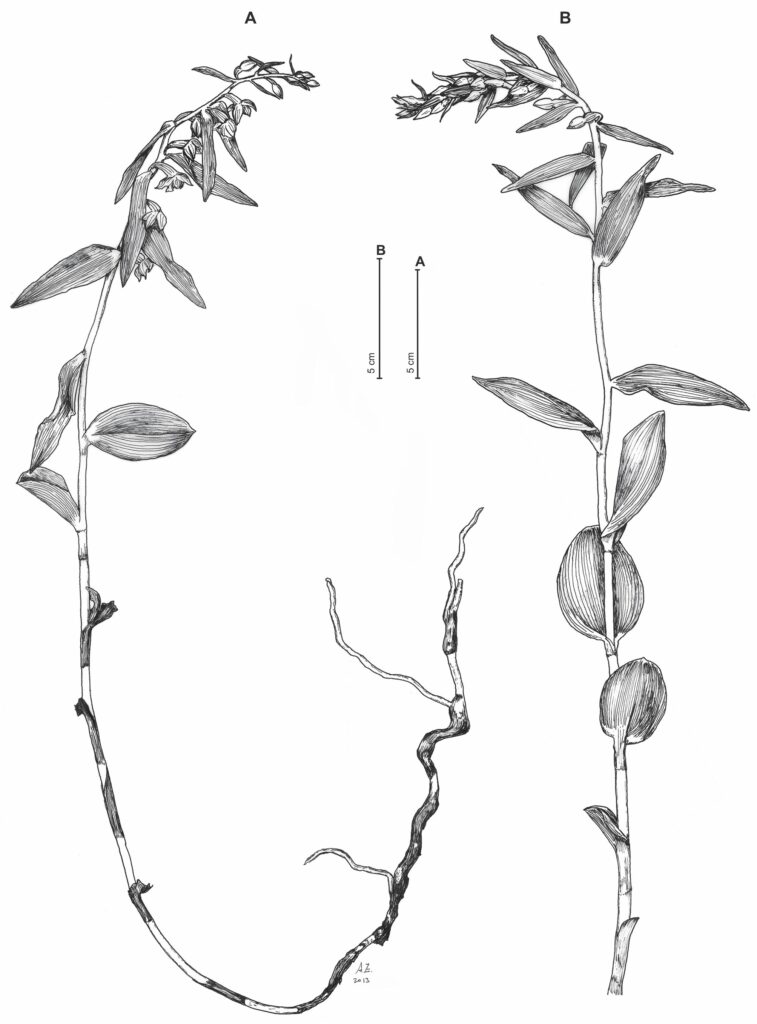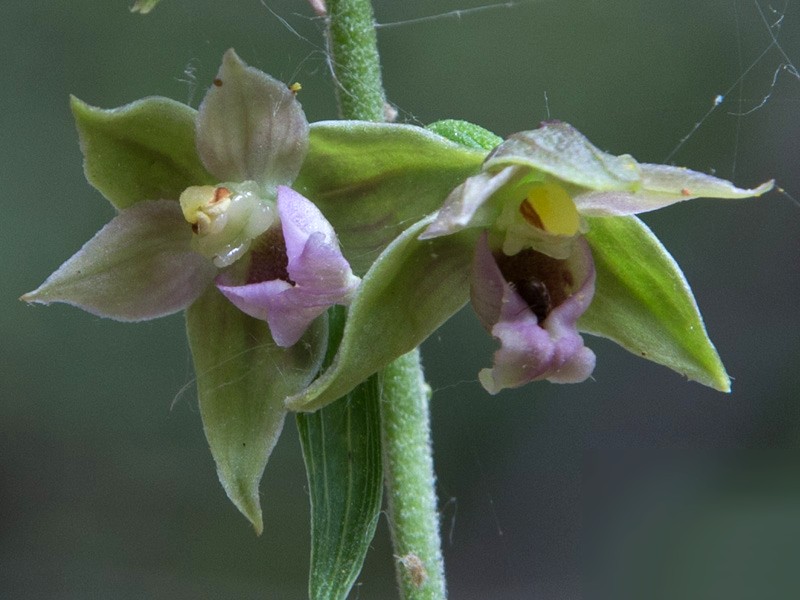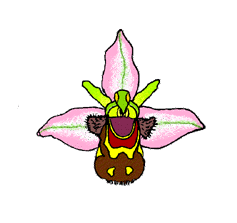Caratteri essenziali distintivi rispetto a E. helleborine: pianta verde (non arrossata), solitamente con singolo scapo rigido (raramente cespitosa), alto 25-60(70) cm, con 4-6 foglie con bordi irregolarmente papilloso-denticolati, le inferiori piccole e lungamente guainanti, le mediane ovato-subrotonde (3,2-5 × 2-3,6 cm), ottuse e spesso più corte degli internodi, da eretto-divaricate a patenti, le superiori lanceolate e acute; brattee lineari-lanceolate, le inferiori più lunghe dei fiori (fino a 6 cm). Infiorescenza densa, lunga fino a 25 cm con 14-30(45) fiori aperti e obliqui, predisposti per l’allogamia. Sepali ovato-lanceolati (9,5-11 × 5,5-6,5 mm), acuti, verdi con sfumature violacee; petali ovati, verdi con sfumature rosee; labello con giunzione ipo-epichilo corta e larga; ipochilo (4,5-5 × 5-5.5 mm), internamente bruno-violaceo e con bordi rosei; epichilo (4-4,2 × 5-6 mm) in gran parte ripiegato all’indietro, roseo al centro, bianco-rosato ai lati, ad apice verdastro e diverse callosità rosate plicate longitudinalmente; rostello presente; viscidio efficace; ovario pedicellato, subclavato, leggermente pubescentee.
Protologo di Salvatore Brullo e Angelo Zimmitti 2014:
Epipactis hyblaea Brullo & Zimmitti, sp. nov. …
Type:—ITALY. Sicily: Siracusa, lecceta fresca su substrato calcareo all’interno della Riserva Naturale Orientata “Pantalica, Valle dell’Anapo e Torrente Cava Grande”, 24 May 2012, Zimmitti s.n. (holotype, CAT).
Diagnosis:—Similar to E. distans from which it differs in having stem usually solitary, higher number of basal sheaths, smaller median cauline leaves, which are erect-divaricate to patent and laxly denticulate at margin, sepal smaller, green, ovate to ovate-lanceolate, petal smaller, hypochile larger, epichile longer with more numerous evident plicae in the protuberances, small ovary with longer pedicel; in addition, it is early flowering and grow in shady underwood habitats.
Perennial herbs with an elongate rhizome. Stem 25–60(–73) cm tall, usually solitary, rarely 2–3, erect, rigid, glabrous below, minutely pubescent on the upper surface, with 4(–5) basal sheaths. Cauline leaves 4–6, lax and irregularly denticulate at the margin, with 4–8 teeth per mm, the lowest little developed, 2–3 median leaves subround to round–ovate, obtuse, 3.2–4.5(–5.0) × 2.0–3.6 cm, often shorter than internode, subrigid, erect–divaricate to patent, 1–3 upper ones lanceolate, acute, 6.0 × 1.4–1.6(–2.5) cm. Raceme more or less dense, 15–25 cm long, 14–30(–45) flowered; bracts 1–6 cm, lanceolate to linear–lanceolate, mostly longer than flowers, the upper ones often equalling or shorter than flowers. Flowers obliquely pendent. Ovary subclavate, slightly pedunculate, sparsely hairy, 11.0–14.0 × 4.5–4.7 mm, in section circular with 6 prominent ribs. Sepals ovate to ovate–lanceolate, acute at apex, green tinged with purple, 9.5–11.0 × 5.5–6.5 mm, 5–6 veined. Petals ovate, pinkish–green, pink at the margin, 8.0–9.0 × 4.8–5.8 mm, 7–veined. Labellum 8.5–9.0 mm long; hypochile purplish–brown on the bottom and pinkish above and outside, 4.5–5.0 × 5.0–5.5 mm; epichile cordate, 4.0–4.2 × 5.0–6.0 mm, marginal pinkish–white, pink in the central part, tinged with green at the apex, bent downwards, bosses pink with 9–11 longitudinal plicae. Anther sessile, rounded at apex, leant above the stigma. Clinandrum well developed. Rostellum present. Stigma rectangular, subvertical.
Phenology:—Epipactis hyblaea flowers in May and is in fruit from May to June.
Habitat and distribution:—Epipactis hyblaea occurs at an elevation of ca. 600 m a.s.l., in the Hyblean area (southeastern Sicily). It grows on Miocene marly limestones in the understory of holm oak woodlands, where it is localized in the northern slops of narrow valleys. In this mesic situation, E. hyblaea is a member of sciaphilous community characterized by other orchids, such as Epipactis microphylla and Cephalanthera damasonium (Miller 1768: n. 2) Druce (1906: 225), as well as several other nemoral species, among them Urtica rupestris Gussone (1821: 15), Lamium flexuosum Tenore (1820: 19) etc.
IUCN red list category: omissis
Etimology: omissis
Taxonomic relationships: omissis… active speciation is currently observed within populations belonging to Epipactis helleborine group, occurring mainly in stands located at the margin of the distribution area of this genus, as for instance southern Italy and Sicily. Epipactis hyblaea has an especially close relationships with E. distans…omissis…Based on living material and data the literature, E. hyblaea is morphologically well differentiated from E. distans in several features of leaves and flowers, as well as phenology and ecological requirements. In particular, the most relevant features that allow it to be distinguished from E. distans are, in the latter: fewer basal sheaths, larger median cauline leaves, which are erect to suberect and densely denticulate at the margin, smaller hypochile, smaller epichile with evanescent plicae in the protuberances and larger ovary with shorter pedicel; in addition it is later flowering and grows usually in sunny habitat.
⬆︎ After S. Brullo & A. Zimmitti, 2014: Epipactis hyblaea (Orchidaceae; Epidendroideae; Neottieae) a new species from Sicily. Phytotaxa 186 (1): 42-50.


